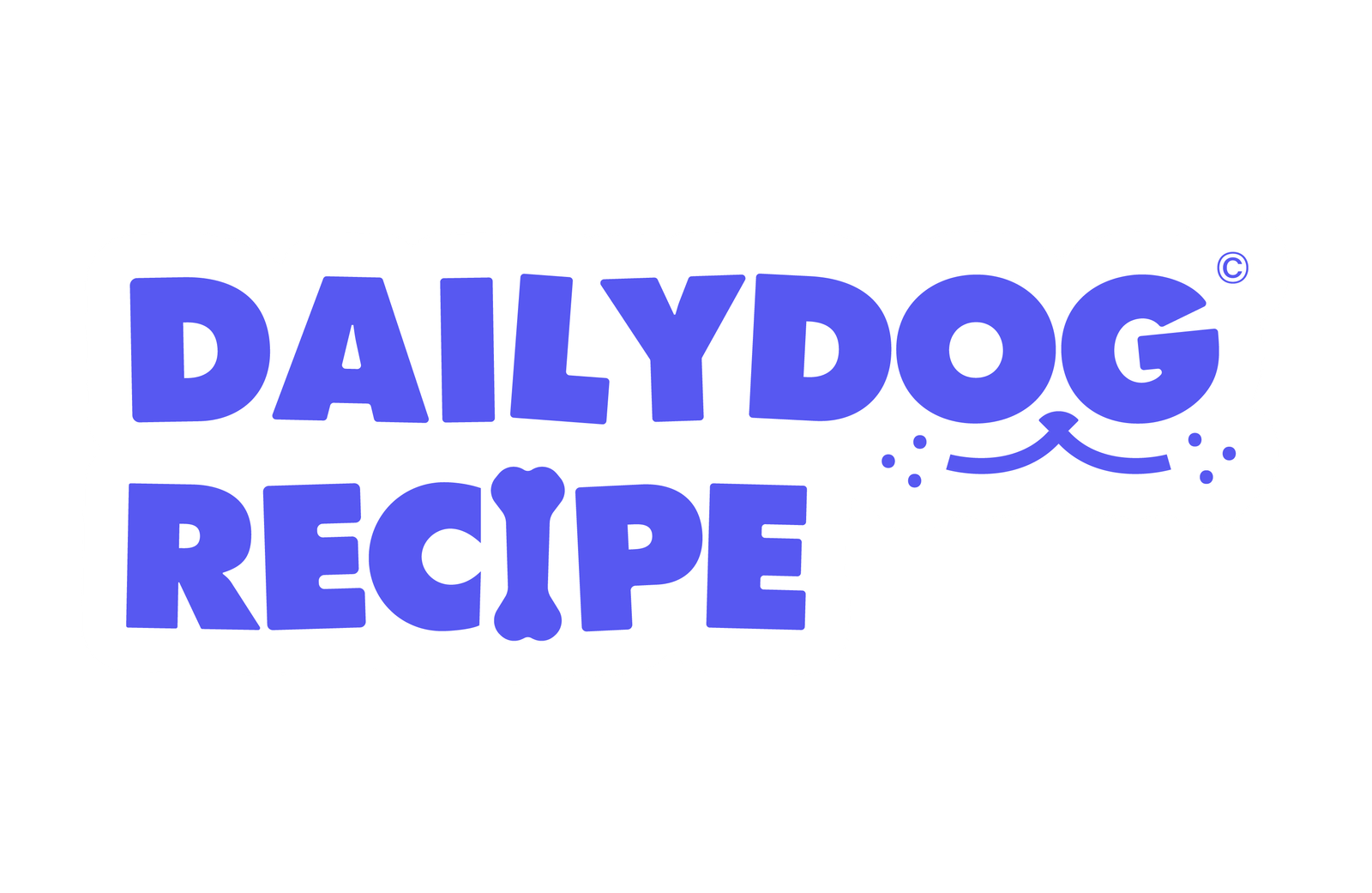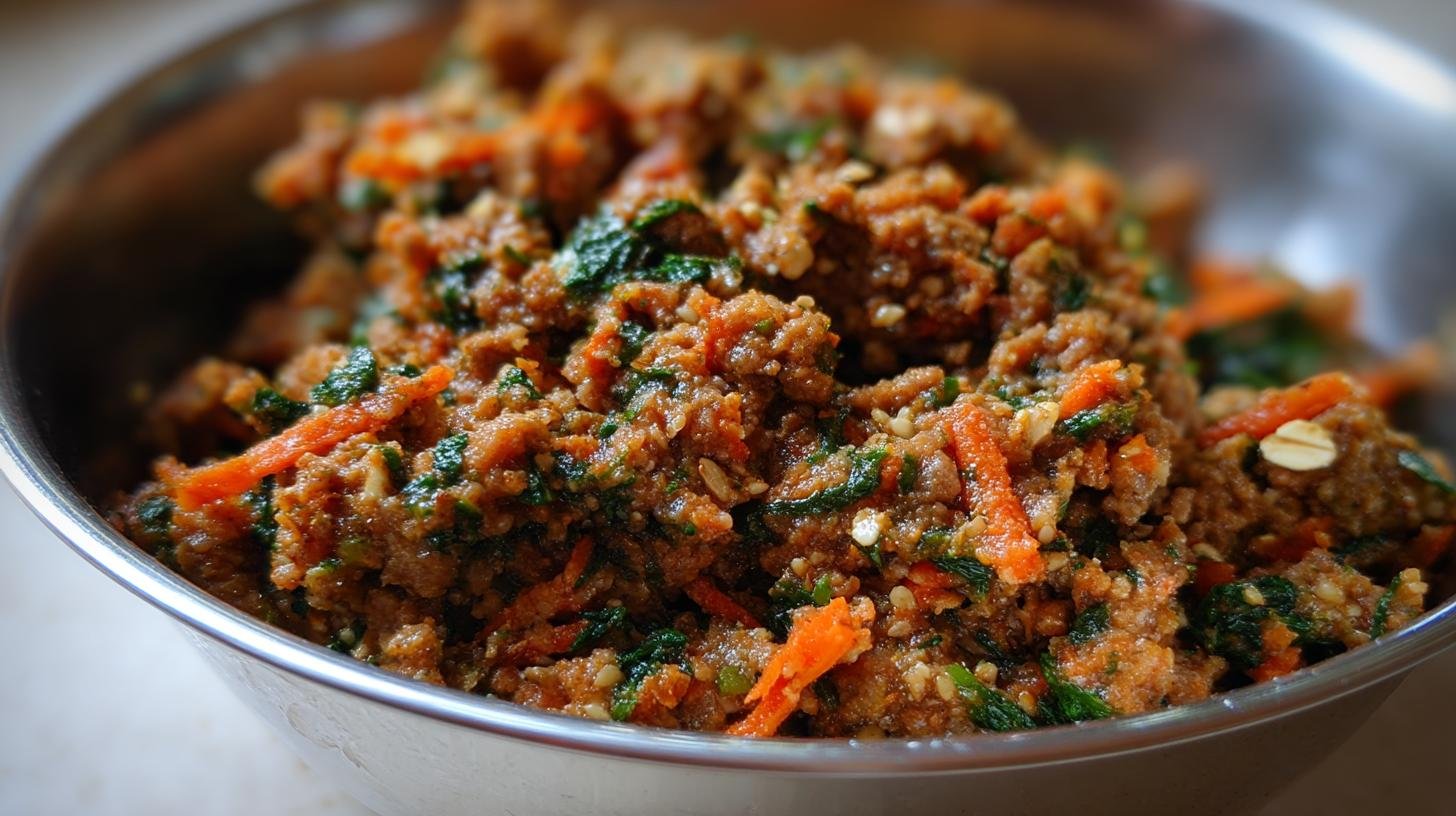If you’ve ever looked at those fancy bags of kibble and thought, “There’s gotta be a healthier, cheaper way,” you are absolutely right. This cost-effective raw dog food recipe saved my budget and helped my pup thrive—shinier coat, better energy, and fewer tummy troubles. I’ve been feeding raw for a few years now, and after lots of trial and error (and some very patient taste-testing from my dog, Max), I landed on this version that’s both affordable and balanced.
I’ve done the homework—reading vet articles, consulting with a pet nutritionist, and adjusting based on Max’s changing needs. This recipe uses simple, store-bought ingredients like ground beef, chicken livers, and veggies that won’t break the bank. Plus, it’s quick to make in big batches and freezes beautifully. Whether you’re just starting out with raw feeding or looking to save money while keeping your dog healthy, this one’s for you.
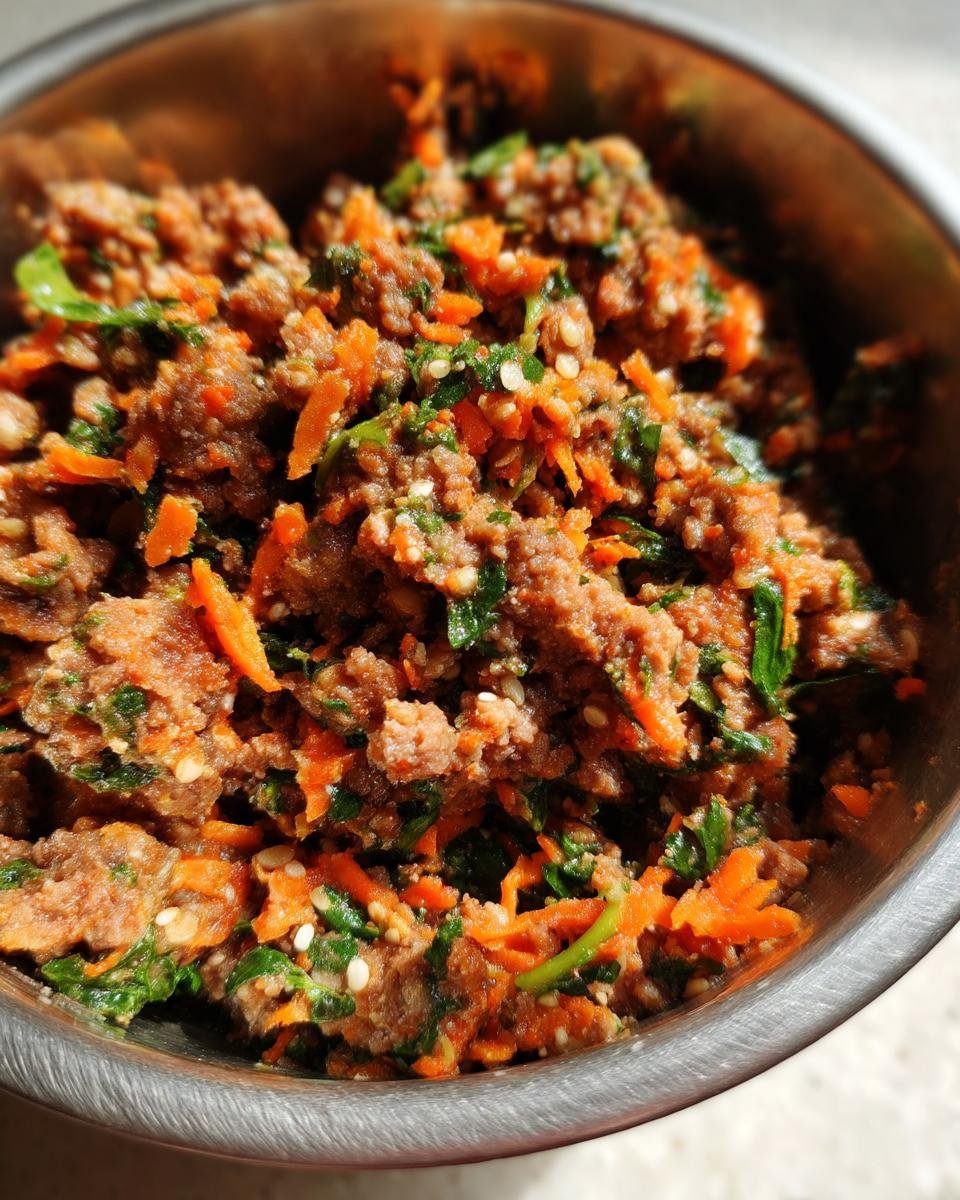
Why You’ll Love This Cost-Effective Raw Dog Food
There are so many reasons this raw dog food recipe has become a regular in my kitchen—and Max’s favorite part of the day. Here’s why you’ll love it too:
- Budget-friendly: Uses affordable ingredients you can buy in bulk or on sale.
- Balanced nutrition: Includes protein, healthy fats, fiber, and calcium to keep your dog thriving.
- Quick to make: Prepping a big batch takes about 15 minutes—no cooking required.
- Freezer-friendly: Portion it out and freeze for weeks of easy meals.
- Customizable: Easily swap proteins or veggies based on what’s available or what your dog loves.
- Happy pups: My dog licks his bowl clean every time—this stuff’s a hit.
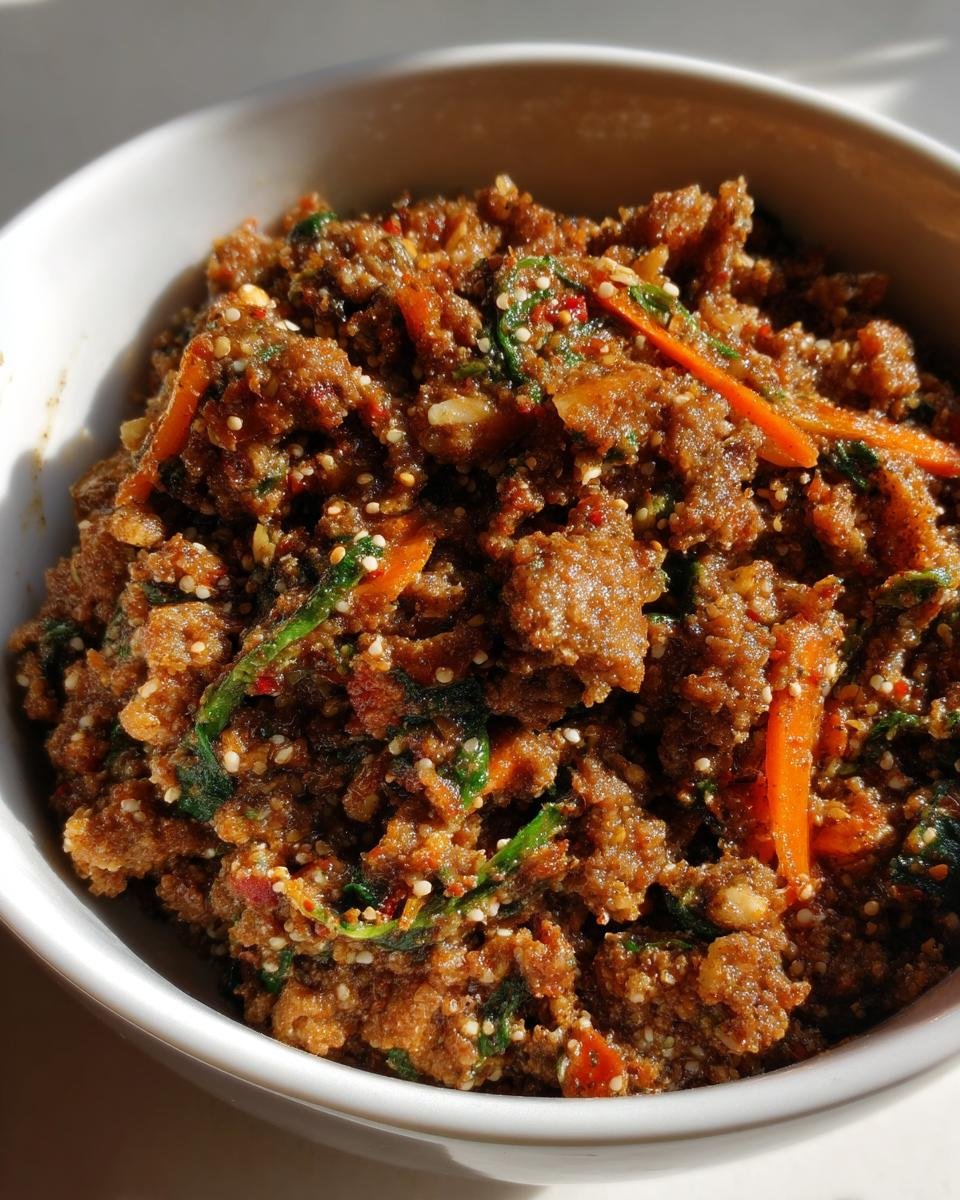
Ingredients for Cost-Effective Raw Dog Food
This recipe uses simple, budget-conscious ingredients that still pack a nutritional punch. I always try to buy meats in bulk when they’re on sale and stock up on frozen veggies to save even more (plus, they don’t spoil as fast!). Here’s what you’ll need:
- 2 lbs ground beef (I use 80/20 for a good fat-to-protein ratio)
- 1 lb chicken livers, chopped (super affordable and full of nutrients)
- 2 cups grated carrots (I usually grab a big bag and shred them myself—it’s cheaper)
- 1 cup chopped spinach (frozen works great and saves time and money)
- 4 raw eggs, with shells (yep, the shells go in too—for calcium!)
- 1 cup rolled oats (adds fiber and helps bind everything together)
- 2 tablespoons ground flaxseed (a budget-friendly omega-3 boost)
Everything here is easy to source at most grocery stores or warehouse clubs. And once you’ve got your staples, you can mix and match to fit your dog’s needs or whatever’s on sale that week!
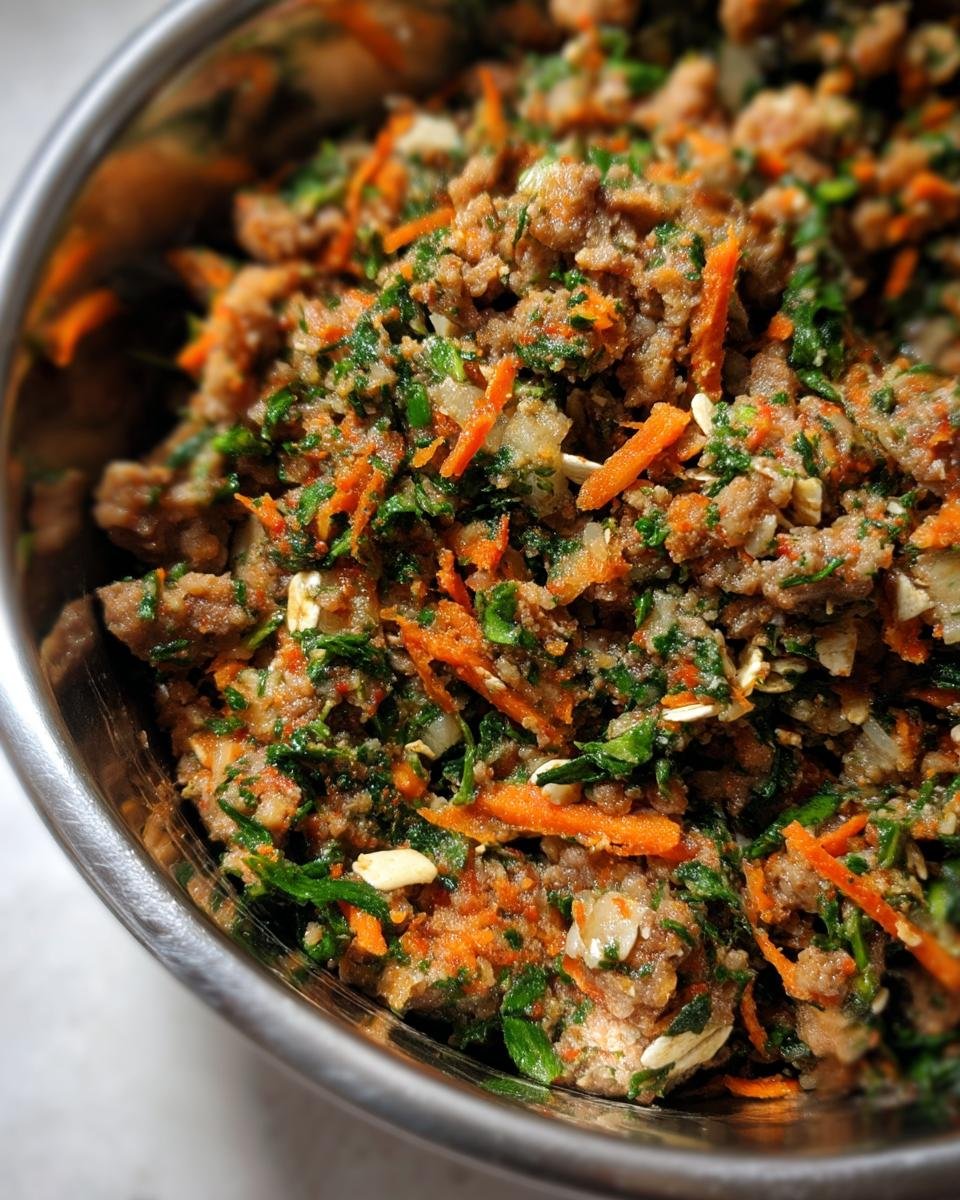
How to Make Cost-Effective Raw Dog Food
This recipe comes together fast once your ingredients are prepped, and trust me—it’s easier than it sounds. I usually set aside 15–20 minutes on a weekend to make a big batch for the week (or even longer if I freeze extras). All you need is a large mixing bowl, a box grater, and a spoon or gloved hands for mixing. That’s it!
- Start by prepping your ingredients (see tips below). Get everything chopped, grated, and ready to go before mixing.
- Combine ground beef and chopped chicken livers in a large bowl first. This forms the protein base of your mix.
- Add in your grated carrots and chopped spinach. Make sure the veggies are evenly spread so each portion gets a little bit of everything.
- Crack the eggs into a separate bowl, crush the shells finely, and whisk it all together. You want the shells broken down enough that they’re safe and easy to digest.
- Stir in the eggs, rolled oats, and flaxseed. These help bind the mixture and add fiber and healthy fats.
- Mix until everything is fully incorporated. I use gloved hands for this step—it’s messy but way easier than a spoon.
- Portion into containers based on your dog’s daily serving size. I like using reusable freezer-safe containers or silicone molds for quick thawing.
And that’s it! Just pop your portions in the freezer and you’re set for the week (or longer). No cooking, no fuss—just real food for your furry buddy.
Prepping Your Ingredients the Right Way
Before you mix anything, take a few minutes to prep everything properly—it really makes a difference. I grate the carrots fresh because they hold more moisture and mix better than the pre-shredded kind. Use a box grater with medium holes so the bits aren’t too chunky or too fine. For spinach, I usually thaw frozen spinach and then chop it up so it blends in smoothly.
Now, for the eggshells—this part’s important. Crush them well! I either use a mortar and pestle or just pop them in a bag and smash them with a rolling pin. You want them finely ground so they’re safe and digestible. And don’t forget: always wash your hands (or wear gloves) and keep your workspace clean since we’re handling raw meat.
Mixing and Portioning Cost-Effective Raw Dog Food
Once everything’s prepped, grab your largest mixing bowl—you’ll need the space. Start with the meats, then work in the veggies, eggs, and dry ingredients. I use gloved hands to mix because it’s faster and helps me feel when everything’s evenly combined (plus, my dog hangs around hoping for a dropped bit—watch your toes!).
When it’s fully mixed, scoop the food into your storage containers. I portion by weight, based on my dog’s daily needs, and freeze individual servings so I can grab one the night before to thaw. BPA-free reusable containers or silicone molds both work great and make mealtime super easy.
Ingredient Substitutes for Cost-Effective Raw Dog Food
One of the best parts about this recipe is how flexible it is—you can totally adjust it based on what’s on sale or what your dog tolerates best. If ground beef’s pricey that week, I swap it for ground pork or turkey. Pork adds a bit more fat, which can be great for active dogs, while turkey is leaner and usually easy to digest.
Can’t find chicken livers? Turkey livers or even beef liver work just as well—just keep organ meats to about 10% of the total mix. For veggies, kale is a great substitute for spinach, especially if you find a good frozen bag on sale. And if your dog’s sensitive to oats or flaxseed, you can skip or replace them with chia seeds or cooked quinoa.
Always watch for allergies, especially when trying new proteins. Start small and see how your pup reacts!
Tips for Success with Cost-Effective Raw Dog Food
Once you get into the rhythm of raw feeding, it honestly becomes second nature—but a few little tricks can make it even smoother. I always thaw Max’s meals in the fridge overnight in a sealed container so it’s ready by breakfast. If I forget (oops!), a quick water bath does the trick in a pinch.
Keep an eye on your dog’s body condition—if they’re getting pudgy, cut back on oats or up the veggies a bit. For high-energy dogs, I lean more into protein and fats. I also rotate proteins every few weeks to keep things interesting and balanced. Max gets bored fast, so I mix it up with turkey or pork now and then.
And last tip—label your containers! Trust me, mystery meat surprises aren’t fun at 6 a.m.
Storage and Reheating Guidelines
Once you’ve portioned your cost-effective raw dog food, pop the containers into the freezer right away. They’ll stay fresh for up to 3 months when frozen. For the fridge, only keep what you’ll use within 2–3 days—any longer and it’s a risk, especially with raw meat.
Thaw portions overnight in the fridge whenever possible. If you’re in a rush (been there!), you can place a sealed container in a bowl of cold water for faster thawing. Just remember—never microwave or cook this food! It’s meant to be served raw to preserve all those nutrients your pup needs.
Nutritional Information
Each 1/2 cup serving of this cost-effective raw dog food provides an estimated 200 calories, with about 12g of fat (including 4g saturated), 18g of protein, 5g of carbohydrates, and 2g of fiber. There’s also roughly 90mg of cholesterol and 65mg of sodium per serving. These values are approximate and can vary depending on the exact ingredients and brands you use, but it gives you a solid baseline for planning your dog’s daily intake.
Cost-Effective Raw Dog Food FAQs
Can I use different meats in this budget-friendly recipe?
Absolutely! One of the best parts about homemade pet food is the flexibility. I often swap ground beef for turkey or pork depending on what’s cheaper that week. Turkey is leaner, which can be great for dogs who need to watch their fat intake. Pork has a bit more fat and flavor, which some pups love—mine included! Just be sure to stick with fresh, good-quality meat and adjust portions if you’re changing fat content.
Is this raw dog food safe for all dog breeds?
In general, yes—this affordable raw diet is safe for most dogs, but I always recommend chatting with your vet before switching, especially if your dog is a puppy, a senior, or has allergies or health conditions. Every dog is different, and a vet can help you tweak the recipe if needed. I did that when Max was a pup, and it helped me feel confident I was doing it right from the start.
How do I know how much to feed my dog daily?
A good rule of thumb is to feed about 2–3% of your dog’s ideal body weight per day. So, for a 50-pound dog, that’s roughly 1 to 1.5 pounds of food daily. Active dogs may need more, couch potatoes less. I started with that estimate and adjusted based on Max’s weight and energy level. Your vet or a pet nutritionist can help you get more specific if needed.
Can I skip the egg shells?
You can, but you’ll need to replace the calcium somehow. Eggshells are a natural, budget-friendly calcium source, which is super important for bone health. If your dog doesn’t tolerate them or you’d rather not use them, try a canine calcium powder instead—just make sure it’s safe for raw diets and follow the dosage instructions. No bones about it, calcium is key!
Share Your Thoughts
I’d love to hear how this cost-effective raw dog food recipe worked for you and your pup! Did your dog gobble it up like mine does? Did you try any fun substitutions or add-ins? Drop a comment below to share your experience, rate the recipe, or pass along any tips you’ve learned along the way. Your feedback helps other dog parents, and I always enjoy hearing how your furry friends are doing!
Print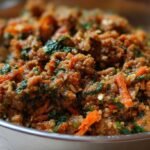
Cost-Effective Raw Dog Food That Cut My Costs by 40%
- Total Time: 15 minutes
- Yield: 20 servings 1x
- Diet: Gluten Free
Description
A balanced, budget-friendly raw dog food recipe using affordable ingredients to provide essential nutrients for your pet.
Ingredients
- 2 lbs ground beef (80/20 lean/fat ratio)
- 1 lb chicken livers (inexpensive organ meat source)
- 2 cups grated carrots (low-cost vegetable option)
- 1 cup chopped spinach (frozen works for cost savings)
- 4 raw eggs (with shells for calcium)
- 1 cup rolled oats (affordable fiber source)
- 2 tbsp flaxseed (budget-friendly omega-3 source)
Instructions
- Combine ground beef and chopped chicken livers in large mixing bowl
- Mix in grated carrots and chopped spinach until evenly distributed
- Crush egg shells and whisk with eggs before adding to meat mixture
- Stir in rolled oats and flaxseed to bind ingredients
- Portion into reusable containers and freeze for daily use
Notes
- Buy meat in bulk when on sale for better pricing
- Use frozen vegetables to reduce costs and prevent spoilage
- Adjust quantities based on your dog’s weight and activity level
- Substitute proteins with turkey or pork for variety
- Prep Time: 15 minutes
- Cook Time: 0 minutes
- Category: Dog Food
- Method: Raw
- Cuisine: Pet Food
Nutrition
- Serving Size: 1/2 cup (approx 100g)
- Calories: 200
- Sugar: 1g
- Sodium: 65mg
- Fat: 12g
- Saturated Fat: 4g
- Unsaturated Fat: 6g
- Trans Fat: 0g
- Carbohydrates: 5g
- Fiber: 2g
- Protein: 18g
- Cholesterol: 90mg
